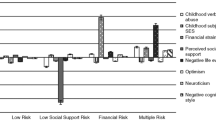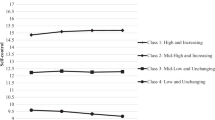Abstract
Emerging adulthood is characterized by not only opportunity and transition but also a substantial increase in risk behaviors (Fosco et al. Journal of Family Psychology, 26(4), 565–575, 2012; Johnston et al. 2016). Building on prior research, we tested a mediational model hypothesizing that Family Check-Up (FCU) intervention effects on young adult risk would be mediated by increases in self-regulation, and that these changes would continue to affect risk behavior as high school youths transitioned to young adulthood. We also predicted that the intent-to-treat intervention would be associated with lower levels of risk in young adulthood and that this effect would be accounted for by intervention-induced improvements in self-regulation during early adolescence, which in turn would prevent young adult risk. Participants were 593 adolescents and their families recruited from three public middle schools and randomized either to the FCU or to a control group. Item response theory was applied to construct a measure of high-risk behavior at this age, including risk behaviors such as substance abuse, high-risk sexual behavior, and vocational risk. Results suggested that changes in children’s self-regulation that occurred early during the middle school years, and that were associated with the FCU, led to reductions in risk behaviors during young adulthood. This study builds on our prior research that has suggested that effects of the FCU during middle school lead to changes in a range of risk behaviors during the transition to high school (Fosco et al. Journal of School Psychology, 51(4), 455–468, 2013; Stormshak et al. School Mental Health, 2(2), 82–9, 2010).

Similar content being viewed by others
References
Achenbach, T. M., & Rescorla, L. A. (2001). Manual for the ASEBA school-age forms and profiles. Burlington: University of Vermont, Research Center for Children, Youth, and Families.
Arnett, J. J. (2006). Emerging adulthood: Understanding the new way of coming of age. In J. J. Arnett & J. L. Tanner (Eds.), Emerging adults in America: Coming of age in the 21st century (pp. 3–19). Washington, DC: American Psychological Association.
Blair, R. J. R. (2002). Neuro-cognitive models of acquired sociopathy and developmental psychopathy. In J. Glicksohn (Ed.), The neurobiology of criminal behavior (pp. 157–186). Dordrecht: Kluwer Academic Publishers.
Brown, H. C., Wang, W., Kellam, S. G., Muthén, B. O., Petras, H., Toyinbo, P., et al. (2008). Methods for testing theory and evaluating impact in randomized field trials: Intent-to-treat analyses for integrating the perspectives of person, place, and time. Drug and Alcohol Dependence, 95, S74–S104. https://doi.org/10.1016/j.drugalcdep.2007.11.013.
Campos, J. J., Campos, R. G., & Barrett, K. C. (1989). Emergent themes in the study of emotional development and emotion regulation. Developmental Psychology, 25, 394–402. https://doi.org/10.1037/0012-1649.25.3.394.
Center for Behavioral Health Statistics and Quality. (2015). Behavioral health trends in the United States: Results from the 2014 National Survey on Drug Use and Health. HHS Publication No. SMA 15-4927, NSDUH Series H-50. Retrieved from http://www.samhsa.gov/ data/.
Centers for Disease Control and Prevention. (2010). Sexually transmitted disease surveillance, 2009. Atlanta: U.S. Department of Health and Human Services Retrieved from http://www.cdc.gov/std/stats09/surv2009-Complete.pdf.
Chang, H., Shaw, D. S., Dishion, T. J., Gardner, F., & Wilson, M. N. (2014). Direct and indirect effects of the Family Check-Up on self-regulation from toddlerhood to early school-age. Journal of Abnormal Child Psychology, 42, 1117–1128. https://doi.org/10.1007/s10802-014-9859-8.
Child and Family Center. (2001). Young Adult Risk Scale. Unpublished instrument available from the Prevention Science Institute. Eugene: University of Oregon.
Conduct Problems Prevention Research Group. (2013). Assessing findings from the Fast Track study. Journal of Experimental Criminology, 9, 119–126. https://doi.org/10.1007/s11292-013-9173-4.
Connell, A. M., Klostermann, S., & Dishion, T. J. (2012). Family Check-Up effects on adolescent arrest trajectories: Variation by developmental subtype. Journal of Research on Adolescence, 22, 367–380. https://doi.org/10.1111/j.1532-7795.2011.00765.x.
Crockett, L. J., Raffaelli, M., & Shen, Y. L. (2006). Linking self-regulation and risk proneness to risky sexual behavior: Pathways through peer pressure and early substance use. Journal of Research on Adolescence, 16, 503–525. https://doi.org/10.1111/j.1532-7795.2006.00505.x.
DeVellis, R. F. (2012). Scale development: Theory and application (3rd ed.). Los Angeles: Sage.
Dishion, T. J., & Kavanagh, K. (2003). Intervening with adolescent problem behavior: A family-centered approach. New York: Guilford.
Dishion, T. J., & Stormshak, E. A. (2007). Intervening in children’s lives: An ecological, family-centered approach to mental health care. Washington, DC: American Psychological Association.
Dishion, T. J., Stormshak, E. A., & Kavanagh, K. (2011). Everyday parenting: A professional’s guide to building family management skills. Champaign: Research Press.
Dodge, K. A. (2001). Mediation, moderation, and mechanisms in how parenting affects children’s aggressive behavior. In J. G. Borkowski, S. L. Ramey, & M. Bristol-Power (Eds.), Parenting and the child’s world: Influences on academic, intellectual, and social–emotional development (pp. 215–230). Hove: Psychology Press.
Dodge, K. A., Greenberg, M. T., & Malone, P. S. (2008). Testing an idealized dynamic cascade model of the development of serious violence in adolescence. Child Development, 79, 1907–1927. https://doi.org/10.1111/j.1467-8624.2008.01233.x.
Eisenberg, N., Zhou, Q., Spinrad, T. L., Valiente, C., Fabes, R. A., & Liew, J. (2005). Relations among positive parenting, children’s effortful control, and externalizing problems: A three-wave longitudinal study. Child Development, 76, 1055–1071. https://doi.org/10.1111/j.1467-8624.2005.00897.x.
Ellis, L. K., & Rothbart, M. K. (2005). Revision of the Early Adolescent Temperament Questionnaire (EAT-Q). Unpublished instrument.
Embretson, S. E., & Reise, S. P. (2013). Item response theory. New York: Psychology Press.
Fosco, G. M., Caruthers, A. S., & Dishion, T. J. (2012). A six-year predictive test of adolescent family relationship quality and effortful control pathways to emerging adult social and emotional health. Journal of Family Psychology, 26, 565–575. https://doi.org/10.1037/a0028873.
Fosco, G. M., Frank, J. L., Stormshak, E. A., & Dishion, T. J. (2013). Opening the “black box”: Family Check-Up intervention effects on self-regulation that prevents growth in problem behavior and substance use. Journal of School Psychology, 51, 455–468. https://doi.org/10.1016/j.jsp.2013.02.001.
Gupta, S. K. (2011). Intention-to-treat concept: A review. Perspectives in Clinical Research, 2, 109–112.
Johnston, L. D., O’Malley, P. M., Bachman, J. G., & Schulenberg, J. E. (2004). National survey results on drug use from the Monitoring the Future study, 1975–2003: Volume I. Secondary school students. Volume II. College students and adults age 19–45. Bethesda: National Institute on Drug Abuse.
Johnston, L. D., O’Malley, P. M., Bachman, J. G., Schulenberg, J. E., & Miech, R. A. (2016). Monitoring the Future national survey results on drug use, 1975–2015: Volume II, College students and adults ages 19–55. Ann Arbor: Institute for Social Research, The University of Michigan.
Kenny, D. A., & Judd, C. M. (2014). Power anomalies in testing mediation. Psychological Science, 25, 334–339. https://doi.org/10.1177/0956797613502676.
Kovacs, M. (1992). Child depression inventory (CDI) manual. North Tonawanda: Multi-Health Systems, Inc..
Kraemer, H., Wilson, G., Fairburn, C. G., & Agras, W. (2002). Mediators and moderators of treatment effects in randomized clinical trials. Archives of General Psychiatry, 59, 877–883. https://doi.org/10.1001/archpsyc.59.10.877.
Laurent, H., & Powers, S. (2007). Emotion regulation in emerging adult couples: Temperament, attachment, and HPA response to conflict. Biological Psychology, 76, 61–71. https://doi.org/10.1016/j.biopsycho.2007.06.002.
Lengua, L. J. (2009). Effortful control in the context of socioeconomic and psychosocial risk. Psychological Science Agenda, 23.
MacKinnon, D. P. (2008). Introduction to statistical mediation. New York: Psychology Press.
Masten, A. S., & Cicchetti, D. (2010). Developmental cascades. Development and Psychopathology, 22, 491–495. https://doi.org/10.1017/S0954579410000222.
Metzler, C. W., Biglan, A., Ary, D. V., & Li, F. (1998). The stability and validity of early adolescents’ reports of parenting practices constructs. Journal of Family Psychology, 12, 600–619. https://doi.org/10.1037/0893-3200.12.4.600.
Metzler, C. W., Biglan, A., Rusby, J. C., & Sprague, J. R. (2001). Evaluation of a comprehensive behavior management program to improve school-wide positive behavior support. Education & Treatment of Children, 24, 448–479.
Miller, W. R., & Rollnick, S. (2002). Motivational interviewing: Preparing people for change (2nd ed.). New York: Guilford.
Morris, A. S., Silk, J. S., Steinberg, L., Myers, S. S., & Robinson, L. R. (2007). The role of family context in the development of emotion regulation. Social Development, 16, 361–388. https://doi.org/10.1111/j.1467-9507.2007.00389.x.
Mullin, B. C., & Hinshaw, S. P. (2007). Emotion regulation and externalizing disorders in children and adolescents. In J. J. Gross (Ed.), Handbook of emotion regulation (pp. 523–541). New York: Guilford Press.
Muthén, L. K., & Muthén, B. O. (2015). Mplus user’s guide. Los Angeles: Muthén & Muthén.
Preacher, K. J., & Hayes, A. F. (2008). Asymptotic and resampling strategies for assessing and comparing indirect effects in multiple mediator models. Behavior Research Methods, 40, 879–891. https://doi.org/10.3758/BRM.40.3.879.
Reise, S. P., & Waller, N. G. (2003). How many IRT parameters does it take to model psychopathology items? Psychological Methods, 8, 164–184. https://doi.org/10.1037/1082-989X.8.2.164.
Stormshak, E. A., & Dishion, T. J. (2009). A school-based, family-centered intervention to prevent substance use: The Family Check-Up. The American Journal of Drug and Alcohol Abuse, 35, 227–232. https://doi.org/10.1080/00952990903005908.
Stormshak, E. A., Connell, A. M., & Dishion, T. J. (2009). An adaptive approach to family-centered intervention in schools: Linking intervention engagement to academic outcomes in middle and high school. Prevention Science, 10, 221–235. https://doi.org/10.1007/s11121-009-0131-3.
Stormshak, E. A., Fosco, G. M., & Dishion, T. J. (2010). Implementing interventions with families in schools to increase youth school engagement: The Family Check-Up model. School Mental Health, 2, 82–92. https://doi.org/10.1007/s12310-009-9025-6.
Stormshak, E. A., Connell, A. M., Véronneau, M. H., Myers, M. W., Dishion, T. J., Kavanagh, K., & Caruthers, A. S. (2011). An ecological approach to promoting early adolescent mental health and social adaptation: Family-centered intervention in public middle schools. Child Development, 82, 209–225. https://doi.org/10.1111/j.1467-8624.2010.01551.x.
Stormshak, E. A., DeVargas, E., & Cardenas, L. (2017). Parenting practices and the development of problem behavior across the lifespan. In J. E. Lochman & W. Matthys (Eds.), The Wiley handbook of disruptive and impulse-control disorders. New York: Wiley.
Substance Abuse and Mental Health Services Administration. (2013). Behavioral Health Barometer: United States, 2013. HHS publication no. SMA-13-4796. Rockville: Substance Abuse and Mental Health Services Administration.
Sulik, M. J., Blair, C., Mills-Koonce, R., Berry, D., & Greenberg, M. (2015). Early parenting and the development of externalizing behavior problems: Longitudinal mediation through children’s executive function. Child Development, 86, 1588–1603. https://doi.org/10.1111/cdev.12386.
Van Ryzin, M. J., Fosco, G. M., & Dishion, T. J. (2012). Family and peer predictors of substance use from early adolescence to early adulthood: An 11-year prospective analysis. Addictive Behaviors, 37, 1314–1324. https://doi.org/10.1016/j.addbeh.2012.06.020.
Weiss, D. J., & Yoes, M. E. (1991). Item response theory. In Advances in educational and psychological testing: Theory and applications (pp. 69–95). Dordrecht: Springer.
Zeman, J., Cassano, M., & Adrian, M. C. (2013). Socialization influences on children’s and adolescents’ emotional self-regulation processes. In K. C. Barrett, N. A. Fox, G. A. Morgan, D. J. Fidler, & L. A. Daunhauer (Eds.), Handbook of self-regulatory processes in development: New directions and international perspectives (pp. 79–106). New York: Psychology Press.
Author information
Authors and Affiliations
Corresponding author
Ethics declarations
Conflicts of Interest
There are no conflicts of interest, and all ethical standards were followed in conducting this research.
Ethical Approval
All procedures performed in studies involving human participants were in accordance with the ethical standards of the institutional and/or national research committee and with the 1964 Helsinki declaration and its later amendments or comparable ethical standards.
Informed Consent
Informed consent was obtained from all subjects and procedures were approved by the University of Oregon IRB.
Rights and permissions
About this article
Cite this article
Stormshak, E., DeGarmo, D., Chronister, K. et al. The Impact of Family-Centered Prevention on Self-Regulation and Subsequent Long-Term Risk in Emerging Adults. Prev Sci 19, 549–558 (2018). https://doi.org/10.1007/s11121-017-0852-7
Published:
Issue Date:
DOI: https://doi.org/10.1007/s11121-017-0852-7




